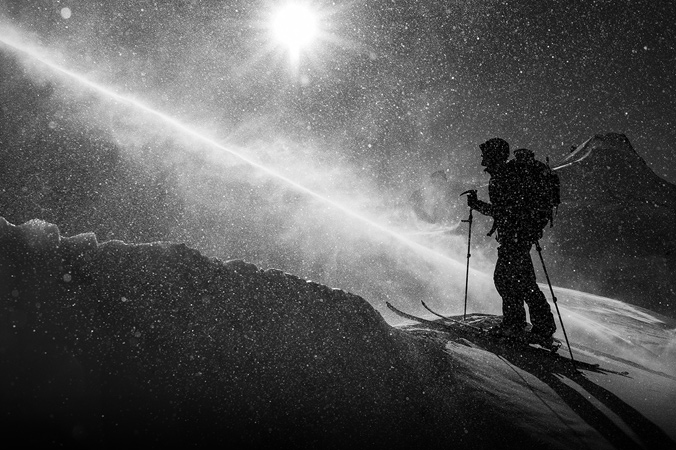
Louie Dawson pushes higher. Coleman-Deming Route, Mt. Baker, Wash. [Photo] Jason Hummel
An overhanging rock face looms to our left, and I can see the Coleman Glacier sprawling far below my feet. Kyle and I are on the Hourglass, a 50-degree ramp that gains Mt. Baker, Wash.’s North Ridge. Early this morning, after a few soggy hours of sleep in Murkwood Camp, we’d navigated the crevasses of the Lower Coleman where the rain had held off. Now, it’s falling steadily. The wind whips at the skis lashed to the side of my pack, and our agreed-upon 1 p.m. turnaround time is drawing near.
I climb meticulously—a fall here would ruin the day, if not the summer—while Kyle climbs more confidently, using one axe instead of two. He’s scrambled up many a snowfield on Colorado’s 14ers, while my experience is limited mostly to the ravines of New Hampshire’s Mt. Washington.
As we crest the ridge, the wind doubles, and we shout our assessments. Kyle thinks the two ice pitches below the summit cap will go quickly, but neither of us has much experience leading ice. We can’t see more than 50 yards up the ridge, and the seracs are probably three or four hundred yards away. We’ll be post-holing our way there.
My major misgiving, I shout to Kyle, is the wet-slab danger we’ll face when we try to ski off the summit; the snow is already too soft for comfort. He agrees but thinks the snow might get better with elevation.
“Let’s get to the seracs and reassess,” he yells.
So we head up the ridge. With ice climbing gear and skis heavy on my back, I feel every beer and donut I consumed last week. Through clouds, we catch intermittent glimpses of the seracs.
Before long we’re within shouting distance of our goal, one I’d been dreaming of for the past month since running into another party while descending Baker’s Coleman-Deming Route. They’d described how the North Ridge perfectly flowed from the summit cap and deemed the ice pitches super easy. Kyle has wanted to try this route for years, and this is the one time all summer when our schedules align. We both know that a successful summit and ski down is entirely possible.
But we’re socked in. The wind and rain have grown steadier while the snow has become softer than a Slush-Puppie. It’s not 1 p.m., but I know it will be before we finish climbing the first ice pitch. Even though I want to ski this route, even though I long to ski from the summit, I know what this means.
“Kyle,” I holler. “We should turn back. The visibility sucks. It’s raining hard, it’s windy, it’s warm, and there’s real avalanche danger if we stay out much longer.”
Without hesitation, he yells back: “I think you’re right! We’ll get it another time.”
I feel relief as we plod down the ridge, but soon I start second-guessing the decision. Maybe the snow would have been fine. Maybe, if I had been faster, we could have gotten up and over. Kyle has wanted this longer than I have, and I made the decision to turn around. Our one shot for the summer is a failure, and it’s my fault.
But Kyle is smiling as we descend the ridge to the glacier. “Man, it was gnarly up there,” he says. “We definitely made the right call.”
His optimism changes my mood, and I begin to appreciate our position on the side of this mountain. I look down at the yawning blue crevasses, the rippled snowfields and the spires of black volcanic rock scraping toward the windblown clouds that engulf the summit. It’s a wild, wide-open place, and there are no other humans in sight. The disappointment of falling short of our goal fades, and after descending the Hourglass, we traverse high across the glacier to where we link together pockets of soft snow down Heliotrope Ridge.
Two hours later, we clink beers at the North Fork Brewery, satisfied with the journey. From here, turning back looks less like a failure and more like a reason to someday try again.










Related posts:
The Trendsetter: How Diny Harrison, the first North American woman to earn an international mountain…
Backstory: The Struggle for Enlightenment
Covering Ground: How to plan a dialed multiday traverse
The Great Bardini: Celebrating the influence of the late Allan Bard